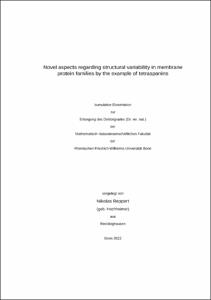Novel aspects regarding structural variability in membrane protein families by the example of tetraspanins

Novel aspects regarding structural variability in membrane protein families by the example of tetraspanins

| dc.contributor.advisor | Lang, Thorsten | |
| dc.contributor.author | Reppert, Nikolas | |
| dc.date.accessioned | 2022-11-16T16:00:51Z | |
| dc.date.available | 2022-11-16T16:00:51Z | |
| dc.date.issued | 16.11.2022 | |
| dc.identifier.uri | https://hdl.handle.net/20.500.11811/10442 | |
| dc.description.abstract | The work at hand focuses on structural variability in membrane protein families by the example of tetraspanins. The family of tetraspanins is found in almost all multicellular organisms and they play important roles in an exceptionally broad range of cellular processes. Tetraspanins are small membrane proteins that contain four transmembrane segments (TMSs). The TMSs are connected on the extracellular side by a small and a large extracellular loop between TMS1-TMS2 and TMS3-TMS4, respectively, and on the cytosolic side by a small intracellular loop between TMS2 and TMS3. The amino and carboxyl termini are also located at the cytosolic site. Two structural aspects of the tetraspanin family were analysed.
First, I addressed the question of alternative splicing and its implications on the family of tetraspanins. A comparative analysis of the known 33 human tetraspanins isoforms listed in the NCBI database revealed a large increase in the number of gene products due to alternative splicing. Surprisingly, these novel isoforms differ in their number of transmembrane domains and therefore represent in fact mono-, di- and trispanins. This allows for a classification into four classes of non-conventional tetraspanins. Expression of these non-conventional tetraspanins shows that alternative splicing can effect ER exit and non-conventional tetraspanins could modulate tetraspanin-enriched microdomain function. To my knowledge, this study is the first analysis of alternative splicing of a whole membrane protein family. After exploring the realm of structural possibilities in the tetraspanin family that is associated with non-conventional tetraspanins, I refocused my work on segments modulating the structure of conventional tetraspanins. The center of this effort evolved around the small intracellular loop (SIL), the tetraspanins’ least studied domain, which connects TMS2 and TMS3. In human and other animal tetraspanins, the sequence analysis of this domain yields a conserved five amino acid core sequence. The two available crystal structures that show the SIL reveal an M shaped backbone of this loop. The M-motifs dihedral angles cement the turn character of this domain and enforce the inversion of the peptide chain orientation between TMS2 and TMS3. The same M-motif, albeit constituted by different amino acids, is found in many other inter-helix turns of other proteins and presents a new class of inter-helix turn of widespread importance. The glutamate at the second SIL core position is of particular interest, because it forms a salt-bridge in CD9 with a conserved lysine at the N-terminal juxta membrane region before TMS1. This salt-bridge regulates protein expression, localization and interaction. This can be explained by the hypothesis of a hinge-like mechanism of the salt-bridge that stabilizes the conformational switch between the tetraspanins’ helix bundle and funnel shape. | en |
| dc.language.iso | eng | |
| dc.rights | In Copyright | |
| dc.rights.uri | http://rightsstatements.org/vocab/InC/1.0/ | |
| dc.subject | Tetraspanine | |
| dc.subject | alternatives Splicing | |
| dc.subject | Salz-Brücke | |
| dc.subject | tetraspanin | |
| dc.subject | alternative splicing | |
| dc.subject | salt-bridge | |
| dc.subject.ddc | 570 Biowissenschaften, Biologie | |
| dc.title | Novel aspects regarding structural variability in membrane protein families by the example of tetraspanins | |
| dc.type | Dissertation oder Habilitation | |
| dc.publisher.name | Universitäts- und Landesbibliothek Bonn | |
| dc.publisher.location | Bonn | |
| dc.rights.accessRights | openAccess | |
| dc.identifier.urn | https://nbn-resolving.org/urn:nbn:de:hbz:5-68527 | |
| dc.relation.doi | https://doi.org/10.1016/j.cub.2020.01.007 | |
| dc.relation.doi | https://doi.org/10.1038/s41598-019-50267-0 | |
| dc.relation.doi | https://doi.org/10.1038/s41598-022-07243-y | |
| ulbbn.pubtype | Erstveröffentlichung | |
| ulbbn.birthname | Hochheimer | |
| ulbbnediss.affiliation.name | Rheinische Friedrich-Wilhelms-Universität Bonn | |
| ulbbnediss.affiliation.location | Bonn | |
| ulbbnediss.thesis.level | Dissertation | |
| ulbbnediss.dissID | 6852 | |
| ulbbnediss.date.accepted | 10.10.2022 | |
| ulbbnediss.institute | Mathematisch-Naturwissenschaftliche Fakultät : Fachgruppe Molekulare Biomedizin / Life & Medical Sciences-Institut (LIMES) | |
| ulbbnediss.fakultaet | Mathematisch-Naturwissenschaftliche Fakultät | |
| dc.contributor.coReferee | Geyer, Matthias | |
| ulbbnediss.contributor.orcid | https://orcid.org/0000-0001-7082-0352 | |
| ulbbnediss.contributor.gnd | 1225562996 |
Files in this item
This item appears in the following Collection(s)
-
E-Dissertationen (4074)




